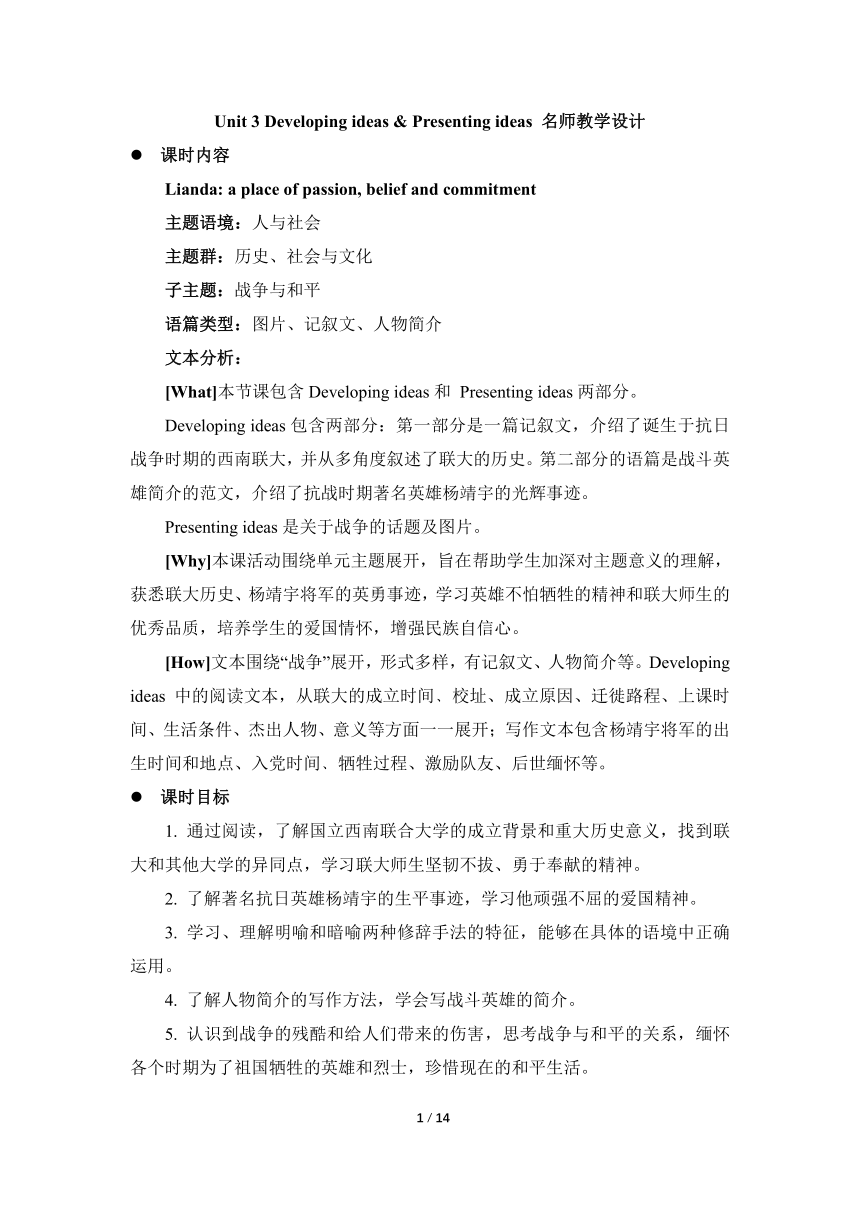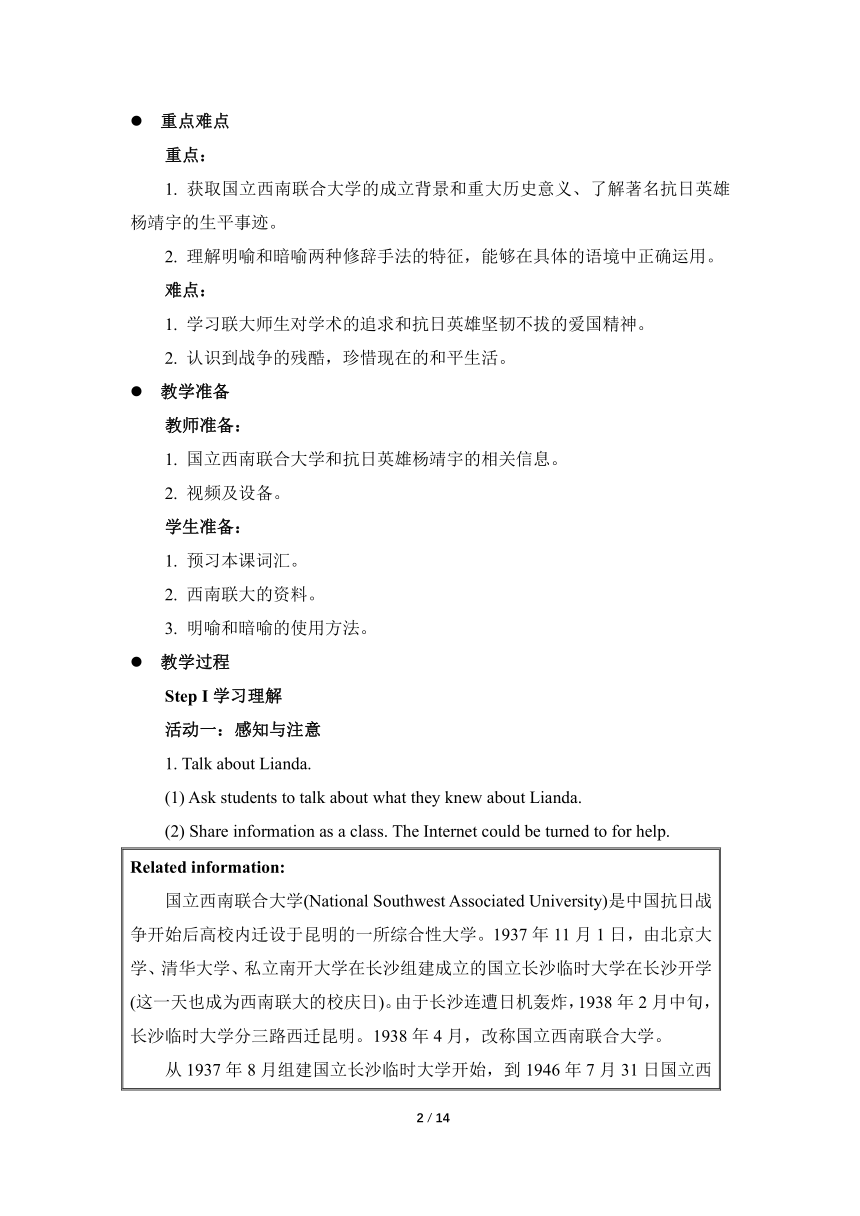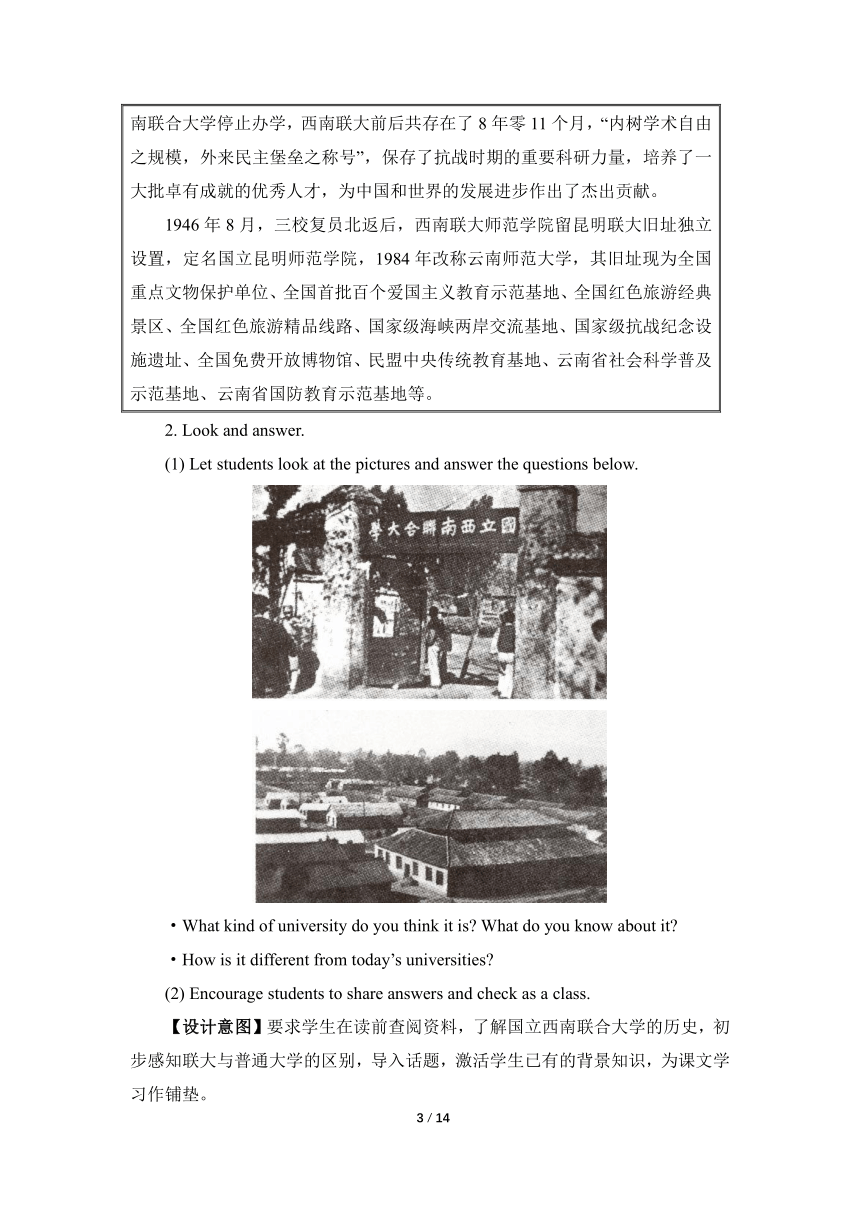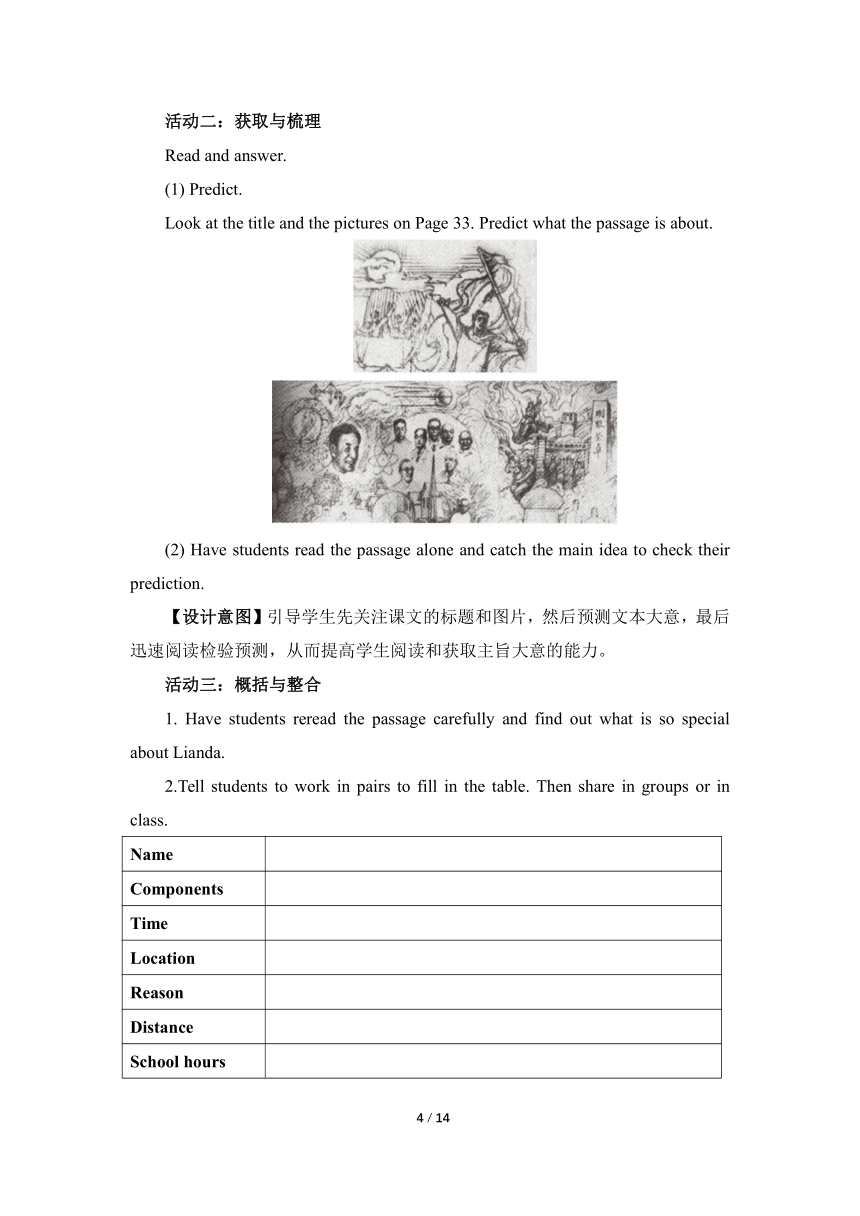外研版(2019) 选择性必修第三册 Unit3 War and peace Developing ideas and Presenting ideas 名师教学设计
文档属性
| 名称 | 外研版(2019) 选择性必修第三册 Unit3 War and peace Developing ideas and Presenting ideas 名师教学设计 |  | |
| 格式 | docx | ||
| 文件大小 | 2.3MB | ||
| 资源类型 | 教案 | ||
| 版本资源 | 外研版(2019) | ||
| 科目 | 英语 | ||
| 更新时间 | 2023-03-05 19:45:07 | ||
图片预览





文档简介
Unit 3 Developing ideas & Presenting ideas 名师教学设计
课时内容
Lianda: a place of passion, belief and commitment
主题语境:人与社会
主题群:历史、社会与文化
子主题:战争与和平
语篇类型:图片、记叙文、人物简介
文本分析:
[What]本节课包含Developing ideas和 Presenting ideas两部分。
Developing ideas包含两部分:第一部分是一篇记叙文,介绍了诞生于抗日战争时期的西南联大,并从多角度叙述了联大的历史。第二部分的语篇是战斗英雄简介的范文,介绍了抗战时期著名英雄杨靖宇的光辉事迹。
Presenting ideas是关于战争的话题及图片。
[Why]本课活动围绕单元主题展开,旨在帮助学生加深对主题意义的理解,获悉联大历史、杨靖宇将军的英勇事迹,学习英雄不怕牺牲的精神和联大师生的优秀品质,培养学生的爱国情怀,增强民族自信心。
[How]文本围绕“战争”展开,形式多样,有记叙文、人物简介等。Developing ideas 中的阅读文本,从联大的成立时间﹑校址、成立原因、迁徙路程、上课时间、生活条件、杰出人物、意义等方面一一展开;写作文本包含杨靖宇将军的出生时间和地点、入党时间﹑牺牲过程、激励队友、后世缅怀等。
课时目标
1. 通过阅读,了解国立西南联合大学的成立背景和重大历史意义,找到联大和其他大学的异同点,学习联大师生坚韧不拔、勇于奉献的精神。
2. 了解著名抗日英雄杨靖宇的生平事迹,学习他顽强不屈的爱国精神。
3. 学习、理解明喻和暗喻两种修辞手法的特征,能够在具体的语境中正确运用。
4. 了解人物简介的写作方法,学会写战斗英雄的简介。
5. 认识到战争的残酷和给人们带来的伤害,思考战争与和平的关系,缅怀各个时期为了祖国牺牲的英雄和烈士,珍惜现在的和平生活。
重点难点
重点:
1. 获取国立西南联合大学的成立背景和重大历史意义、了解著名抗日英雄杨靖宇的生平事迹。
2. 理解明喻和暗喻两种修辞手法的特征,能够在具体的语境中正确运用。
难点:
1. 学习联大师生对学术的追求和抗日英雄坚韧不拔的爱国精神。
2. 认识到战争的残酷,珍惜现在的和平生活。
教学准备
教师准备:
1. 国立西南联合大学和抗日英雄杨靖宇的相关信息。
2. 视频及设备。
学生准备:
1. 预习本课词汇。
2. 西南联大的资料。
3. 明喻和暗喻的使用方法。
教学过程
Step I学习理解
活动一:感知与注意
1. Talk about Lianda.
(1) Ask students to talk about what they knew about Lianda.
(2) Share information as a class. The Internet could be turned to for help.
Related information: 国立西南联合大学(National Southwest Associated University)是中国抗日战争开始后高校内迁设于昆明的一所综合性大学。1937年11月1日,由北京大学、清华大学、私立南开大学在长沙组建成立的国立长沙临时大学在长沙开学(这一天也成为西南联大的校庆日)。由于长沙连遭日机轰炸,1938年2月中旬,长沙临时大学分三路西迁昆明。1938年4月,改称国立西南联合大学。 从1937年8月组建国立长沙临时大学开始,到1946年7月31日国立西南联合大学停止办学,西南联大前后共存在了8年零11个月,“内树学术自由之规模,外来民主堡垒之称号”,保存了抗战时期的重要科研力量,培养了一大批卓有成就的优秀人才,为中国和世界的发展进步作出了杰出贡献。 1946年8月,三校复员北返后,西南联大师范学院留昆明联大旧址独立设置,定名国立昆明师范学院,1984年改称云南师范大学,其旧址现为全国重点文物保护单位、全国首批百个爱国主义教育示范基地、全国红色旅游经典景区、全国红色旅游精品线路、国家级海峡两岸交流基地、国家级抗战纪念设施遗址、全国免费开放博物馆、民盟中央传统教育基地、云南省社会科学普及示范基地、云南省国防教育示范基地等。
2. Look and answer.
(1) Let students look at the pictures and answer the questions below.
·What kind of university do you think it is What do you know about it
·How is it different from today’s universities
(2) Encourage students to share answers and check as a class.
【设计意图】要求学生在读前查阅资料,了解国立西南联合大学的历史,初步感知联大与普通大学的区别,导入话题,激活学生已有的背景知识,为课文学习作铺垫。
活动二:获取与梳理
Read and answer.
(1) Predict.
Look at the title and the pictures on Page 33. Predict what the passage is about.
(2) Have students read the passage alone and catch the main idea to check their prediction.
【设计意图】引导学生先关注课文的标题和图片,然后预测文本大意,最后迅速阅读检验预测,从而提高学生阅读和获取主旨大意的能力。
活动三:概括与整合
1. Have students reread the passage carefully and find out what is so special about Lianda.
2.Tell students to work in pairs to fill in the table. Then share in groups or in class.
Name
Components
Time
Location
Reason
Distance
School hours
Living condition
Pioneers
Significance
Suggested answers: Name: National Southwest Associated University or Lianda Components: Peking University, Tsinghua University, Nankai University Time: 1937 Location: Kunming, the remote and mountainous south-west part of China Reason: In 1937, the aggression of the Japanese army brought disaster to China’s three great universities. To save their educational and intellectual heritage. Distance: more than 2,000 kilometres School hours: before 10 am and after 4 pm Living condition: rough buildings, packed 40 to a room, shortages of food, books, and equipment, fierce air attacks Pioneers: Yang Zhenning, Li Zhengdao, Zha Liangzheng, Xu Yuanchong, ... Significance: Lianda has become the crowning glory of China’s modern universities, not only because of its prominent professors and talented students, but also because of the school’s strong spirit of perseverance and dedication. It has become part of the collective memory of the Chinese nation,with its spirit as the blueprint for all universities in China in the modern era.
【设计意图】通过精读,再次分析联大与普通大学的区别,获取有效信息,并完成表格。该活动进一步加深对课文细节和结构的了解,加深对主题意义的探究。
Step II 应用实践
活动四:描述与阐释
Retell the passage.
(1) Ask students to reread the passage.
(2) Tell students to write a summary.
(3) Have students retell the passage according to the table above and the summary in groups of four.
(4) Invite volunteers to present in class.
【设计意图】在学习理解类活动的基础上,引导学生围绕主题写摘要、复述文本,逐渐实现对语言知识和文化知识的内化,促进语言运用的自动化,助力学生将知识转化为能力。
活动五:分析与判断
Ask students to choose the ideas that are conveyed in the passage and find evidence to support their choices.
①Lianda was the best university in Chinese history.
②The story of Lianda shows Chinese intellectuals’ academic pursuit and patriotism.
③Only under difficult circumstances can students8 succeed.
④Lianda has nurtured many outstanding scholars.
⑤Lianda was a great success only because it had prominent professors and gifted students.
⑥People today still admire the spirit of Lianda.
Suggested answers: ②④⑥
【设计意图】让学生选择文章中所表达的观点,并找到证据支持他们的选择,帮助学生了解联大体现的中国知识分子的学术追求和爱国主义精神,获取联大培养许多优秀学者的事实,理解今日人们仍然钦佩联大精神的理由。
活动六:内化与运用
1. Learning to learn.
(1) Request students to work in groups and read “Learning to learn”.
Learning to learn
Similes and metaphors are two commonly used, but easy to confuse, figures of speech. Similes compare and show similarities in typically different things. Similes usually use connecting words such as like, as, so and resemble. For example, He is as cool as a cucumber. Unlike similes, metaphors make direct comparisons without using connecting words. For example, She has a heart of a lion.
(2) Make students find out what figures of speech are used in the sentences below and discuss how they help to express the author’s emotions.
①Their bed was the dusty road and their roof was the open sky, ... ②They had to live in rough buildings, packed 40 to a room, like sardines.
Suggested answers: ①本句运用了暗喻的修辞手法,描写赶往联大的教授和学生在途中“以天为盖,以地为庐”的艰苦条件。 ②本句运用了明喻的修辞手法,描写联大的居住环境之恶劣。
2. Think and share.
(1) Make students read the questions below and discuss ingroups.
·What difficulties did the professors and students of Lianda encounter How did they deal with these
·What is your understanding of the poem written by Zha Liangzheng
·What contribution did Lianda make to the education of the nation
·In what ways is the theme of war and peace presented differently in the two reading passages in this unit
(2) Encourage students to voice their opinions and check the answers as a class.
Suggested answers: ·They had to travel a long distance to reach Lianda. Throughout the journey,they had no accommodation and had to survive extreme conditions. Also, the conditions in Lianda itself were very harsh. They did not have enough food and studied in rough buildings. Furthermore,their study was often interrupted by air attacks. They had to adapt to these challenges, forinstance, by holding their classes when they were not likely to be bombed. ·(略) ·Many of China’s leading scholars and scientists came from Lianda, including two Nobel Prize winners. Lianda’s spirit has become the blueprint for all universities in China in the modern era. ·The passage on the D-Day landings focuses on war as a military operation,and on how dead soldiers are memorialised. The passage on Lianda focuses on how war affected China’s students and academics, and how they were able to achieve excellence in spite of the great difficulties.
3. Give a talk about the spirit of Lianda.
(1) Tell students to work in groups and discuss the questions below.
·How can you describe the spirit of Lianda
·What examples support your ideas
·What can you learn from the story of Lianda
(2) Ask students to complete the diagram with their ideas and the examples that support them.
Lianda >Spirit: ________ Supporting evidence: ________
>Spirit: ________ Supporting evidence: ________
…
(3) Encourage students to give their presentations to the class.
【设计意图】通过观察两个例句中所用的修辞手法并比较,学习明喻和暗喻,引导学生思考两种修辞手法在例句中的作用;然后以问题为任务,鼓励学生深掘文本,联系实际,深化对主题意义的理解,培养学生的高阶思维能力;再以“联大精神”为话题开展演讲,培养学生的表达能力和思维创新能力。
Step Ⅲ 迁移创新
活动七:Writing
1. Direct students to read the passage on Page 35 and answer the questions.
·Who was Yang Jingyu
·Why did Yang decide to let small groups of his men break through the encirclement
·What did the Japanese find when they killed Yang
·How would you describe Yang’s spirit in your own words
Suggested answers: ·Yang Jingyu was an anti-Japanese hero,who died in a fight against Japanese troops. ·Because at that time there was a critical lack of supplies. ·They found only tree bark,cotton and grass roots, instead of rice in his stomach. ·(略)
2. Request students to talk about other war heroes ingroups and choose one to write about.
3. Ask students to organise their ideas by completing the notes below. Do more research if necessary.
Introduction
Name of the person: __________________________________________________ Background information: ______________________________________________
Main body
Major events (in order): _______________________________________________
Conclusion
Your opinion of this person: ____________________________________________
4. Ask students to write an introduction to the war hero they chose.
5. Request students to work in pairs, make improvements to each other’s writings, share them with the class and better understand how to write about a war hero.
Suggested answer: Dong Cunrui was born into a poor peasant family in Huailai County, Hebei Province on 15 October1929.In 1945 he joined the Eighth Route Army and in March 1947 he joined the Communist Party of China. On 25 May 1948, the battle for the liberation of Longhua began, and the soldiers of the Chinese People’s Liberation Army (PLA) flooded towards Longhua Middle School, the headquarters of the enemy. Six jets of fire from a bridge blocked the path of the PLA troops. The bridge was a fortress built by the enemy, and the PLA troops were stuck under a small slope. At the critical moment, they needed a soldier to blow up the bridge and open a new road for the whole army. “Captain, let me blow it up!” Dong Cunrui said, and his request was granted. Under the cover of another soldier, he rushed to the bridge, but could not find a place to put the explosives. Dong Cunrui then lifted the explosives in his left hand, lit the blasting fuse and blew up the enemy’s fortress. In doing so, he died a hero. The story of Dong Cunrui, who gave his life to create a way forward, has been told all over China until today, and has inspired thousands of young people to make sacrifices in defence of our country’s and people’s interests.
【设计意图】引导学生阅读范文,获取抗日英雄杨靖宇的生平和抗日事迹,学习范文结构(简介、主体、结论),进行仿写,写另一位战斗英雄的简介,感悟英雄的感人事迹,学习英雄的优秀品质,进行知识和思维能力的迁移。
活动八:Presenting ideas
1. Have students work in groups and look at the pictures.
2. Ask students to discuss the questions.
·What can you see in each picture
·What do the pictures tell you about war
Suggested answers: ·In picture one, a distressed child is crying in front of a destroyed building. In picture two, a dead or injured soldier is carried away by his comrades. In picture three, there are many graves of the dead. ·(略)
3. Encourage students to think about the topics, complete the table and add examples or details to support their points. Do more research if necessary.
Why people go to war
Effects of war on people
How we can maintain peace around the world
4. Tell students to prepare a short presentation on one of the topics from the table above or think of another relevant topic. Consider the following:
·the structure of your presentation
·useful words, expressions and structures
5. Encourage students to give their presentations to the class.
【设计意图】要求学生观察图片,谈论战争给人们带来的毁灭性影响,引导学生以演讲的形式分享自己对战争的看法和态度,从而更好地理解战争的残酷性和和平的重要性。
活动九:Reflection
Have students write a reflection after completing this unit. Consider the following:
·What is your understanding of war and peace
·What text types have you learnt about What are their features
·What words, expressions and structures have you learnt
·What improvement have you made in understanding different cultures
·What improvement have you made in using learning strategies and exploring effective ways of learning
·What improvement have you made in analysing and solving problems
【设计意图】要求学生从文本、语言、文化、学习策略和方法、分析和解决问题的能力等方面进行自我评价和总结,并写出自我反思日志。
活动十:想象与创造
Encourage students to search for information about Yenching University and what they can learn from it.
Related information: 燕京大学(Yenching University)是20世纪初由四所美国及英国基督教教会联合在北京开办的大学,也是近代中国规模最大、质量最好、环境最优美的大学之一,创办于1919 年,创始人司徒雷登长期担任燕大校长、校务长,他将燕大的校训确定为“因真理得自由以服务”。1928年春﹐燕京大学与美国哈佛大学合作成立哈佛燕京学社,到1930年代已经跻身于世界一流大学之列,在国内外名声大震。 1942年至1945年,因太平洋战争爆发而被侵华日军封闭的燕京大学曾内迁成都办学,抗战胜利后回到北平复校。在中国高等学校1952年院系调整中,燕京大学被撤销﹐其资产由中华人民共和国中央人民政府接管后被整并,文科、理科多并入北京大学,工科并入清华大学,法学院、社会学系并入北京政法学院(今中国政法大学)。校舍由北京大学接收,其建筑仍为燕京大学古迹。 燕大诞生于五四时期,作为那个时代中国高等教育的重要代表,一开始便与学生爱国民主运动结下不解之缘。存在的33年间,这所大学在教育方法、课程设置、规章制度诸多方面,对中国近代高等教育的发展产生了深刻的影响。
【设计意图】通过了解“燕京大学”的历史,再现战争的残酷性,以及战争状态下中国杰出的教授和才华横溢的学生们的坚韧不拔和勇于奉献的精神。
板书设计
Unit 3 War and peace Period IV Developing ideas & Presenting ideas Ⅰ. 学习理解 活动一:感知与注意 1. Talk about Lianda. 2. Look and answer. 活动二:获取与梳理 Read and answer. 活动三:概括与整合 1. Reread. 2. Fill in the table. Ⅱ. 应用实践 活动四:描述与阐释 Retell the passage. 活动五:分析与判断 Choose the ideas. 活动六:内化与运用 1. Learning to learn. 2. Think and share. 3. Give a talk about the spirit of Lianda. Ⅲ. 迁移创新 活动七:Writing 1. Read and answer. 2. Talk about other war heroes. 3. Complete the notes. 4. Write an introduction to a war hero. 5. Make improvements. 活动八:Presenting ideas 1. Look at the pictures. 2. Discuss the questions. 3. Complete the table. 4. Prepare a short presentation. 5. Give presentations. 活动九:Reflection Write a reflection. 活动十:想象与创造
2 / 2
课时内容
Lianda: a place of passion, belief and commitment
主题语境:人与社会
主题群:历史、社会与文化
子主题:战争与和平
语篇类型:图片、记叙文、人物简介
文本分析:
[What]本节课包含Developing ideas和 Presenting ideas两部分。
Developing ideas包含两部分:第一部分是一篇记叙文,介绍了诞生于抗日战争时期的西南联大,并从多角度叙述了联大的历史。第二部分的语篇是战斗英雄简介的范文,介绍了抗战时期著名英雄杨靖宇的光辉事迹。
Presenting ideas是关于战争的话题及图片。
[Why]本课活动围绕单元主题展开,旨在帮助学生加深对主题意义的理解,获悉联大历史、杨靖宇将军的英勇事迹,学习英雄不怕牺牲的精神和联大师生的优秀品质,培养学生的爱国情怀,增强民族自信心。
[How]文本围绕“战争”展开,形式多样,有记叙文、人物简介等。Developing ideas 中的阅读文本,从联大的成立时间﹑校址、成立原因、迁徙路程、上课时间、生活条件、杰出人物、意义等方面一一展开;写作文本包含杨靖宇将军的出生时间和地点、入党时间﹑牺牲过程、激励队友、后世缅怀等。
课时目标
1. 通过阅读,了解国立西南联合大学的成立背景和重大历史意义,找到联大和其他大学的异同点,学习联大师生坚韧不拔、勇于奉献的精神。
2. 了解著名抗日英雄杨靖宇的生平事迹,学习他顽强不屈的爱国精神。
3. 学习、理解明喻和暗喻两种修辞手法的特征,能够在具体的语境中正确运用。
4. 了解人物简介的写作方法,学会写战斗英雄的简介。
5. 认识到战争的残酷和给人们带来的伤害,思考战争与和平的关系,缅怀各个时期为了祖国牺牲的英雄和烈士,珍惜现在的和平生活。
重点难点
重点:
1. 获取国立西南联合大学的成立背景和重大历史意义、了解著名抗日英雄杨靖宇的生平事迹。
2. 理解明喻和暗喻两种修辞手法的特征,能够在具体的语境中正确运用。
难点:
1. 学习联大师生对学术的追求和抗日英雄坚韧不拔的爱国精神。
2. 认识到战争的残酷,珍惜现在的和平生活。
教学准备
教师准备:
1. 国立西南联合大学和抗日英雄杨靖宇的相关信息。
2. 视频及设备。
学生准备:
1. 预习本课词汇。
2. 西南联大的资料。
3. 明喻和暗喻的使用方法。
教学过程
Step I学习理解
活动一:感知与注意
1. Talk about Lianda.
(1) Ask students to talk about what they knew about Lianda.
(2) Share information as a class. The Internet could be turned to for help.
Related information: 国立西南联合大学(National Southwest Associated University)是中国抗日战争开始后高校内迁设于昆明的一所综合性大学。1937年11月1日,由北京大学、清华大学、私立南开大学在长沙组建成立的国立长沙临时大学在长沙开学(这一天也成为西南联大的校庆日)。由于长沙连遭日机轰炸,1938年2月中旬,长沙临时大学分三路西迁昆明。1938年4月,改称国立西南联合大学。 从1937年8月组建国立长沙临时大学开始,到1946年7月31日国立西南联合大学停止办学,西南联大前后共存在了8年零11个月,“内树学术自由之规模,外来民主堡垒之称号”,保存了抗战时期的重要科研力量,培养了一大批卓有成就的优秀人才,为中国和世界的发展进步作出了杰出贡献。 1946年8月,三校复员北返后,西南联大师范学院留昆明联大旧址独立设置,定名国立昆明师范学院,1984年改称云南师范大学,其旧址现为全国重点文物保护单位、全国首批百个爱国主义教育示范基地、全国红色旅游经典景区、全国红色旅游精品线路、国家级海峡两岸交流基地、国家级抗战纪念设施遗址、全国免费开放博物馆、民盟中央传统教育基地、云南省社会科学普及示范基地、云南省国防教育示范基地等。
2. Look and answer.
(1) Let students look at the pictures and answer the questions below.
·What kind of university do you think it is What do you know about it
·How is it different from today’s universities
(2) Encourage students to share answers and check as a class.
【设计意图】要求学生在读前查阅资料,了解国立西南联合大学的历史,初步感知联大与普通大学的区别,导入话题,激活学生已有的背景知识,为课文学习作铺垫。
活动二:获取与梳理
Read and answer.
(1) Predict.
Look at the title and the pictures on Page 33. Predict what the passage is about.
(2) Have students read the passage alone and catch the main idea to check their prediction.
【设计意图】引导学生先关注课文的标题和图片,然后预测文本大意,最后迅速阅读检验预测,从而提高学生阅读和获取主旨大意的能力。
活动三:概括与整合
1. Have students reread the passage carefully and find out what is so special about Lianda.
2.Tell students to work in pairs to fill in the table. Then share in groups or in class.
Name
Components
Time
Location
Reason
Distance
School hours
Living condition
Pioneers
Significance
Suggested answers: Name: National Southwest Associated University or Lianda Components: Peking University, Tsinghua University, Nankai University Time: 1937 Location: Kunming, the remote and mountainous south-west part of China Reason: In 1937, the aggression of the Japanese army brought disaster to China’s three great universities. To save their educational and intellectual heritage. Distance: more than 2,000 kilometres School hours: before 10 am and after 4 pm Living condition: rough buildings, packed 40 to a room, shortages of food, books, and equipment, fierce air attacks Pioneers: Yang Zhenning, Li Zhengdao, Zha Liangzheng, Xu Yuanchong, ... Significance: Lianda has become the crowning glory of China’s modern universities, not only because of its prominent professors and talented students, but also because of the school’s strong spirit of perseverance and dedication. It has become part of the collective memory of the Chinese nation,with its spirit as the blueprint for all universities in China in the modern era.
【设计意图】通过精读,再次分析联大与普通大学的区别,获取有效信息,并完成表格。该活动进一步加深对课文细节和结构的了解,加深对主题意义的探究。
Step II 应用实践
活动四:描述与阐释
Retell the passage.
(1) Ask students to reread the passage.
(2) Tell students to write a summary.
(3) Have students retell the passage according to the table above and the summary in groups of four.
(4) Invite volunteers to present in class.
【设计意图】在学习理解类活动的基础上,引导学生围绕主题写摘要、复述文本,逐渐实现对语言知识和文化知识的内化,促进语言运用的自动化,助力学生将知识转化为能力。
活动五:分析与判断
Ask students to choose the ideas that are conveyed in the passage and find evidence to support their choices.
①Lianda was the best university in Chinese history.
②The story of Lianda shows Chinese intellectuals’ academic pursuit and patriotism.
③Only under difficult circumstances can students8 succeed.
④Lianda has nurtured many outstanding scholars.
⑤Lianda was a great success only because it had prominent professors and gifted students.
⑥People today still admire the spirit of Lianda.
Suggested answers: ②④⑥
【设计意图】让学生选择文章中所表达的观点,并找到证据支持他们的选择,帮助学生了解联大体现的中国知识分子的学术追求和爱国主义精神,获取联大培养许多优秀学者的事实,理解今日人们仍然钦佩联大精神的理由。
活动六:内化与运用
1. Learning to learn.
(1) Request students to work in groups and read “Learning to learn”.
Learning to learn
Similes and metaphors are two commonly used, but easy to confuse, figures of speech. Similes compare and show similarities in typically different things. Similes usually use connecting words such as like, as, so and resemble. For example, He is as cool as a cucumber. Unlike similes, metaphors make direct comparisons without using connecting words. For example, She has a heart of a lion.
(2) Make students find out what figures of speech are used in the sentences below and discuss how they help to express the author’s emotions.
①Their bed was the dusty road and their roof was the open sky, ... ②They had to live in rough buildings, packed 40 to a room, like sardines.
Suggested answers: ①本句运用了暗喻的修辞手法,描写赶往联大的教授和学生在途中“以天为盖,以地为庐”的艰苦条件。 ②本句运用了明喻的修辞手法,描写联大的居住环境之恶劣。
2. Think and share.
(1) Make students read the questions below and discuss ingroups.
·What difficulties did the professors and students of Lianda encounter How did they deal with these
·What is your understanding of the poem written by Zha Liangzheng
·What contribution did Lianda make to the education of the nation
·In what ways is the theme of war and peace presented differently in the two reading passages in this unit
(2) Encourage students to voice their opinions and check the answers as a class.
Suggested answers: ·They had to travel a long distance to reach Lianda. Throughout the journey,they had no accommodation and had to survive extreme conditions. Also, the conditions in Lianda itself were very harsh. They did not have enough food and studied in rough buildings. Furthermore,their study was often interrupted by air attacks. They had to adapt to these challenges, forinstance, by holding their classes when they were not likely to be bombed. ·(略) ·Many of China’s leading scholars and scientists came from Lianda, including two Nobel Prize winners. Lianda’s spirit has become the blueprint for all universities in China in the modern era. ·The passage on the D-Day landings focuses on war as a military operation,and on how dead soldiers are memorialised. The passage on Lianda focuses on how war affected China’s students and academics, and how they were able to achieve excellence in spite of the great difficulties.
3. Give a talk about the spirit of Lianda.
(1) Tell students to work in groups and discuss the questions below.
·How can you describe the spirit of Lianda
·What examples support your ideas
·What can you learn from the story of Lianda
(2) Ask students to complete the diagram with their ideas and the examples that support them.
Lianda >Spirit: ________ Supporting evidence: ________
>Spirit: ________ Supporting evidence: ________
…
(3) Encourage students to give their presentations to the class.
【设计意图】通过观察两个例句中所用的修辞手法并比较,学习明喻和暗喻,引导学生思考两种修辞手法在例句中的作用;然后以问题为任务,鼓励学生深掘文本,联系实际,深化对主题意义的理解,培养学生的高阶思维能力;再以“联大精神”为话题开展演讲,培养学生的表达能力和思维创新能力。
Step Ⅲ 迁移创新
活动七:Writing
1. Direct students to read the passage on Page 35 and answer the questions.
·Who was Yang Jingyu
·Why did Yang decide to let small groups of his men break through the encirclement
·What did the Japanese find when they killed Yang
·How would you describe Yang’s spirit in your own words
Suggested answers: ·Yang Jingyu was an anti-Japanese hero,who died in a fight against Japanese troops. ·Because at that time there was a critical lack of supplies. ·They found only tree bark,cotton and grass roots, instead of rice in his stomach. ·(略)
2. Request students to talk about other war heroes ingroups and choose one to write about.
3. Ask students to organise their ideas by completing the notes below. Do more research if necessary.
Introduction
Name of the person: __________________________________________________ Background information: ______________________________________________
Main body
Major events (in order): _______________________________________________
Conclusion
Your opinion of this person: ____________________________________________
4. Ask students to write an introduction to the war hero they chose.
5. Request students to work in pairs, make improvements to each other’s writings, share them with the class and better understand how to write about a war hero.
Suggested answer: Dong Cunrui was born into a poor peasant family in Huailai County, Hebei Province on 15 October1929.In 1945 he joined the Eighth Route Army and in March 1947 he joined the Communist Party of China. On 25 May 1948, the battle for the liberation of Longhua began, and the soldiers of the Chinese People’s Liberation Army (PLA) flooded towards Longhua Middle School, the headquarters of the enemy. Six jets of fire from a bridge blocked the path of the PLA troops. The bridge was a fortress built by the enemy, and the PLA troops were stuck under a small slope. At the critical moment, they needed a soldier to blow up the bridge and open a new road for the whole army. “Captain, let me blow it up!” Dong Cunrui said, and his request was granted. Under the cover of another soldier, he rushed to the bridge, but could not find a place to put the explosives. Dong Cunrui then lifted the explosives in his left hand, lit the blasting fuse and blew up the enemy’s fortress. In doing so, he died a hero. The story of Dong Cunrui, who gave his life to create a way forward, has been told all over China until today, and has inspired thousands of young people to make sacrifices in defence of our country’s and people’s interests.
【设计意图】引导学生阅读范文,获取抗日英雄杨靖宇的生平和抗日事迹,学习范文结构(简介、主体、结论),进行仿写,写另一位战斗英雄的简介,感悟英雄的感人事迹,学习英雄的优秀品质,进行知识和思维能力的迁移。
活动八:Presenting ideas
1. Have students work in groups and look at the pictures.
2. Ask students to discuss the questions.
·What can you see in each picture
·What do the pictures tell you about war
Suggested answers: ·In picture one, a distressed child is crying in front of a destroyed building. In picture two, a dead or injured soldier is carried away by his comrades. In picture three, there are many graves of the dead. ·(略)
3. Encourage students to think about the topics, complete the table and add examples or details to support their points. Do more research if necessary.
Why people go to war
Effects of war on people
How we can maintain peace around the world
4. Tell students to prepare a short presentation on one of the topics from the table above or think of another relevant topic. Consider the following:
·the structure of your presentation
·useful words, expressions and structures
5. Encourage students to give their presentations to the class.
【设计意图】要求学生观察图片,谈论战争给人们带来的毁灭性影响,引导学生以演讲的形式分享自己对战争的看法和态度,从而更好地理解战争的残酷性和和平的重要性。
活动九:Reflection
Have students write a reflection after completing this unit. Consider the following:
·What is your understanding of war and peace
·What text types have you learnt about What are their features
·What words, expressions and structures have you learnt
·What improvement have you made in understanding different cultures
·What improvement have you made in using learning strategies and exploring effective ways of learning
·What improvement have you made in analysing and solving problems
【设计意图】要求学生从文本、语言、文化、学习策略和方法、分析和解决问题的能力等方面进行自我评价和总结,并写出自我反思日志。
活动十:想象与创造
Encourage students to search for information about Yenching University and what they can learn from it.
Related information: 燕京大学(Yenching University)是20世纪初由四所美国及英国基督教教会联合在北京开办的大学,也是近代中国规模最大、质量最好、环境最优美的大学之一,创办于1919 年,创始人司徒雷登长期担任燕大校长、校务长,他将燕大的校训确定为“因真理得自由以服务”。1928年春﹐燕京大学与美国哈佛大学合作成立哈佛燕京学社,到1930年代已经跻身于世界一流大学之列,在国内外名声大震。 1942年至1945年,因太平洋战争爆发而被侵华日军封闭的燕京大学曾内迁成都办学,抗战胜利后回到北平复校。在中国高等学校1952年院系调整中,燕京大学被撤销﹐其资产由中华人民共和国中央人民政府接管后被整并,文科、理科多并入北京大学,工科并入清华大学,法学院、社会学系并入北京政法学院(今中国政法大学)。校舍由北京大学接收,其建筑仍为燕京大学古迹。 燕大诞生于五四时期,作为那个时代中国高等教育的重要代表,一开始便与学生爱国民主运动结下不解之缘。存在的33年间,这所大学在教育方法、课程设置、规章制度诸多方面,对中国近代高等教育的发展产生了深刻的影响。
【设计意图】通过了解“燕京大学”的历史,再现战争的残酷性,以及战争状态下中国杰出的教授和才华横溢的学生们的坚韧不拔和勇于奉献的精神。
板书设计
Unit 3 War and peace Period IV Developing ideas & Presenting ideas Ⅰ. 学习理解 活动一:感知与注意 1. Talk about Lianda. 2. Look and answer. 活动二:获取与梳理 Read and answer. 活动三:概括与整合 1. Reread. 2. Fill in the table. Ⅱ. 应用实践 活动四:描述与阐释 Retell the passage. 活动五:分析与判断 Choose the ideas. 活动六:内化与运用 1. Learning to learn. 2. Think and share. 3. Give a talk about the spirit of Lianda. Ⅲ. 迁移创新 活动七:Writing 1. Read and answer. 2. Talk about other war heroes. 3. Complete the notes. 4. Write an introduction to a war hero. 5. Make improvements. 活动八:Presenting ideas 1. Look at the pictures. 2. Discuss the questions. 3. Complete the table. 4. Prepare a short presentation. 5. Give presentations. 活动九:Reflection Write a reflection. 活动十:想象与创造
2 / 2
